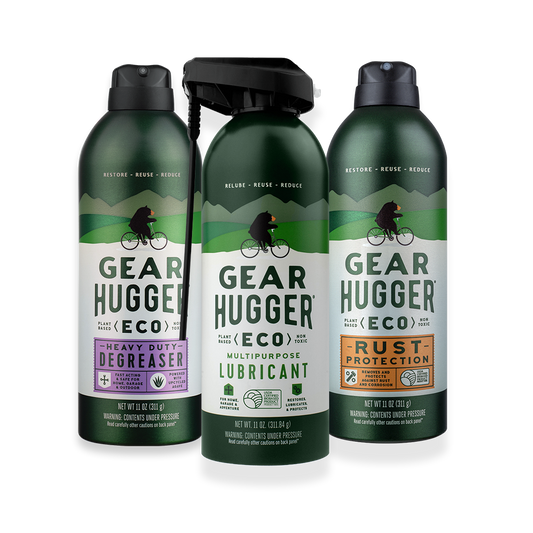Why is bicycle lubrication important?
Lubrication is what keeps the different parts of your bike from rubbing together and wearing. When you lubricate properly and with the right lubricant, everything should work friction-free. This, in turn, will protect your bike parts from wearing prematurely and will allow you to get the most out of them before you need to replace them.How to lubricate the different parts of a bike
Contrary to popular belief, not every part of your bike needs to be lubricated. Here are the key areas to oil for best results:- The chain
- The front gears
- The rear gears
- The front and rear derailleurs assemblies
- The brake levers
The chain
This is the most important part of your bike to oil thoroughly. Why? Because it moves more than anything else on your bike. It connects all of the different parts, and takes a lot of stress regularly.To lubricate the chain, first clean it thoroughly to remove debris and build-up. No use in wasting your oil on dirt, right? (Not sure how to clean properly? Read on, we’ll cover that below.) Then spray your oil consistently on the chain by rotating your pedals backward so that the oil has a chance to reach every part of your chain. Cycle through the entire chain. Let the lubrication set in for several hours before you wipe it off before riding.
The front and rear gears
The front gears consist of the chainrings and the crankset. These require a lot of effort to brush and de-grease first. Once you’ve done that thoroughly, you can use a small amount of oil to keep them from binding.The rear gears are more commonly known as the cassette. While some will say that these should be cleaned but not oiled, others recommend that they’re oiled the same as the front gears. As with the front gears, less is more.
The front and rear derailleur assemblies
These are responsible for moving your chain between gears. The pulleys often get neglected, even when cleaning and lubricating properly. You’ll want to carefully apply your lubrication to the pulley and all other moving parts of both front and rear. Not sure how to pinpoint these parts? Shift gears on your bike and watch to see what moves. Then use that visual movement to aim your lubrication.The brake and gear levers
These control your brakes and gear shifts, respectively. You’ll need to apply just a drop or two to keep these moving properly. In this case, less is definitely more. This is one area you’ll need to wipe excess oil from as thoroughly as possible, as remaining oil will attract dust, dirt, and build-up.
What not to lubricate on your bike
Just like there are dedicated areas to oil properly and regularly, there are certain parts of your bike that you should never oil. If you do, it compromises your bike’s integrity and can even be a safety hazard. These areas include:- Brakes (including the braking surface, the brake pads, and anything around them)
- Disc rotators
- Handlebars
A final tip when oiling your bike
We’ve mentioned it a few times, but it’s essential that after the lubricating oil has had time to settle into the area you've used it on (for about 3 hours), you remove the excess oil. If you don’t, it will gum up the area that you just spent a lot of time cleaning and/or it will attract dirt and dust faster, leading to more wear and tear and the need to clean and re-oil even more frequently. Try setting an alarm on your phone to remind yourself to remove the oil after it has had time to settle in. This is super important!
Tools and supplies for cleaning your bike
Here’s what you’ll need to have handy when cleaning and oiling your bike.
- A bike stand:This is technically optional but recommended. It brings the bike up to your level and helps you get the right angle so that you can access all parts easily
- Cleaning rags: Rags are important for cleaning but also oiling properly. Have separate rags for both, or be prepared to clean them thoroughly in between cleaning and oiling.
- Brushes: This is for cleaning thoroughly in between chain links, gears, and more. A toothbrush works well and is gentle on your bike, too.
- Diluted soap and warm water: Water and soap, properly diluted, is important for cleaning and degreasing build-up from your bike. Get one that you trust, and always have more than you think you’ll need.
- A lubricant you can trust: Not all lubricants will take proper care of your bike and its moving parts. Find a reliable one that is not too thick or too thin. Feel put out by the price? Remember that a good quality oil like Gear Hugger uses only a little and gives a lot in it—a little goes a long way, and that means a better investment long-term.
 Your bike’s always there for you, so show it the same love and attention by keeping it greased up and ready to go. And lubricating its most important parts isn’t nearly as daunting as it seems. The steps above will make your time worthwhile and maximize the lifespan of your favorite set of wheels.
Your bike’s always there for you, so show it the same love and attention by keeping it greased up and ready to go. And lubricating its most important parts isn’t nearly as daunting as it seems. The steps above will make your time worthwhile and maximize the lifespan of your favorite set of wheels.







